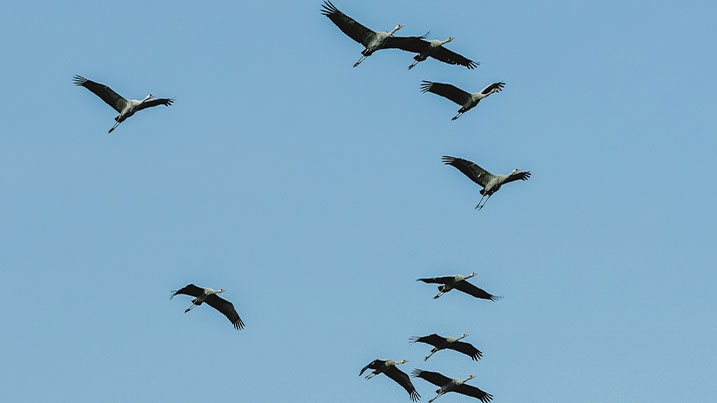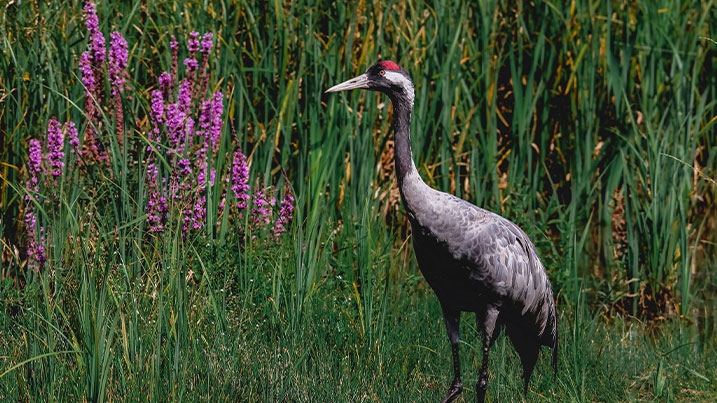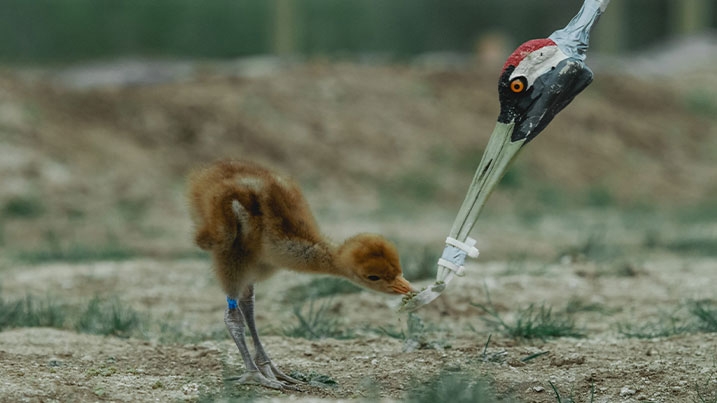Common Crane
Scientific name: Grus grus
Once extinct in the UK, this tall, graceful bird is making a comeback. There’s now a small breeding population in Norfolk and a growing population in the south west after a ground breaking conservation project re-introduced it in Somerset.
Species information
- Height: 110-120 cm
- Wingspan: 220-245 cm
- Weight: 4-7 kg
- Average lifespan: 13 years, although can live up to 30-40 years
- GB Population: UK breeding 48 pairs, UK wintering 150 pairs

Appearance
The common crane is mostly grey, with a distinctive black, red and white head. It has long legs, a long neck and dropping, curved tail feathers.

Where does it Iive?
The common crane lives on treeless moors, on wetlands such as bogs or marshes, or on dwarf heather habitats where small lakes or pools are also found.
What does it eat?
The common crane will eat seeds, roots, insects, snails and worms.
Common cranes at WWT
How is WWT helping cranes?
In 2010, as part of a project to secure the future of the crane in the UK, we raised nearly 100 young cranes over five years at our special ‘crane school’ at Slimbridge using eggs transported from a wild population in Germany. To stop the young chicks imprinting on the humans who were raising them, we used special crane outfits. We taught the cranes the basics of foraging using prosthetic crane heads to help point out small creatures for them to peck at. Insert image
Later we taught them how to react to the threats of humans and foxes with our ‘crane parents’ playing recorded crane alarm calls and role playing the act of flight.
The project was a huge success with 93 young cranes being released into a secret location in the Somerset Levels and Moors over five years. The released birds are surviving and thriving in the wild. The population is now breeding at a number of locations in the southwest and fledging chicks each year.

Where can you see cranes?
Slimbridge Wetland Centre in Gloucestershire is probably the easiest place in the UK to see wild cranes. The birds that we released in Somerset for the Great Crane Project frequently fly up the Severn Estuary to the wetlands of Slimbridge and several have adopted it as their permanent home. Throughout the year they are seen flying overhead and feeding and socialising in front of the hides.
Of the 93 cranes released as part of the Great Crane Project over the past five years, 75 are still alive and well and living in Somerset or at Slimbridge. Because each bird is individually marked, we know who has visited Slimbridge over the years. Although the peak count of birds at Slimbridge on any one day is 16, a total of 43 cranes have visited us. The birds have been named by schoolchildren from Somerset and have wonderful names like Twinkle, Swampy, Bop-bop, Gibble, Excalibird, Elizabeth Royal and Christmas Shoes!
Welney Wetland Centre on the Norfolk/Cambridgeshire border is also regularly visited by cranes from the population in the East of England. Autumn is when activity peaks with birds gathering in a post-breeding flock to feed up, ready for winter. Views of adult cranes along with any juveniles fledged from the summer, can be had from the visitor centre and hides.
In 2018 a pair of cranes bred successfully on the reserve at WWT Welney for the first time. The pair raised a single chick, which fledged over the summer.
Threats to cranes
The main threat to the common crane is habitat loss and degradation caused by drainage, dams, changes in agricultural practice, development and other human activities. This has occurred throughout their range, in breeding and wintering grounds and along migration routes.
How you can help
WWT is one of the largest and most respected wetland conservation charities in the world. In the UK we have ten wetland sites that we manage for the benefit of the wildlife they support. Become a member and get free access all year to explore these extraordinary places while knowing that your membership is also helping us save wetlands and their wildlife in the UK and abroad. Plus you’ll receive exciting updates on our wildlife news, find out about events on your doorstep and be the first to hear about our volunteering opportunities.
Join us